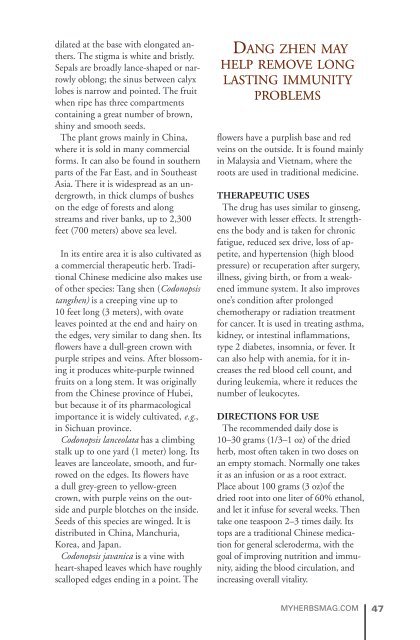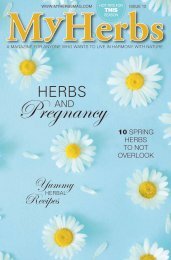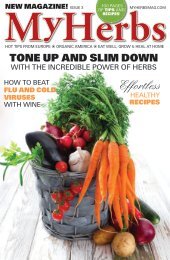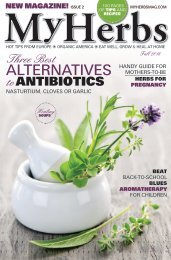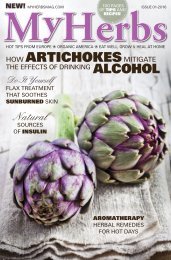My Herbs 1
Find out more on MYHERBS-STORE.COM. My Herbs is a special quarterly publication for anyone who is interested in alternative cooking, home grown herbs, and traditional or complementary medicine or healing methods, simply for everyone who wants to live in harmony with nature.
Find out more on MYHERBS-STORE.COM.
My Herbs is a special quarterly publication for anyone who is interested in alternative cooking, home grown herbs, and traditional or complementary medicine or healing methods, simply for everyone who wants to live in harmony with nature.
You also want an ePaper? Increase the reach of your titles
YUMPU automatically turns print PDFs into web optimized ePapers that Google loves.
dilated at the base with elongated anthers.<br />
The stigma is white and bristly.<br />
Sepals are broadly lance-shaped or narrowly<br />
oblong; the sinus between calyx<br />
lobes is narrow and pointed. The fruit<br />
when ripe has three compartments<br />
containing a great number of brown,<br />
shiny and smooth seeds.<br />
The plant grows mainly in China,<br />
where it is sold in many commercial<br />
forms. It can also be found in southern<br />
parts of the Far East, and in Southeast<br />
Asia. There it is widespread as an undergrowth,<br />
in thick clumps of bushes<br />
on the edge of forests and along<br />
streams and river banks, up to 2,300<br />
feet (700 meters) above sea level.<br />
In its entire area it is also cultivated as<br />
a commercial therapeutic herb. Traditional<br />
Chinese medicine also makes use<br />
of other species: Tang shen (Codonopsis<br />
tangshen) is a creeping vine up to<br />
10 feet long (3 meters), with ovate<br />
leaves pointed at the end and hairy on<br />
the edges, very similar to dang shen. Its<br />
flowers have a dull-green crown with<br />
purple stripes and veins. After blossoming<br />
it produces white-purple twinned<br />
fruits on a long stem. It was originally<br />
from the Chinese province of Hubei,<br />
but because it of its pharmacological<br />
importance it is widely cultivated, e.g.,<br />
in Sichuan province.<br />
Codonopsis lanceolata has a climbing<br />
stalk up to one yard (1 meter) long. Its<br />
leaves are lanceolate, smooth, and furrowed<br />
on the edges. Its flowers have<br />
a dull grey-green to yellow-green<br />
crown, with purple veins on the outside<br />
and purple blotches on the inside.<br />
Seeds of this species are winged. It is<br />
distributed in China, Manchuria,<br />
Korea, and Japan.<br />
Codonopsis javanica is a vine with<br />
heart-shaped leaves which have roughly<br />
scalloped edges ending in a point. The<br />
DANG ZHEN MAY<br />
HELP REMOVE LONG<br />
LASTING IMMUNITY<br />
PROBLEMS<br />
flowers have a purplish base and red<br />
veins on the outside. It is found mainly<br />
in Malaysia and Vietnam, where the<br />
roots are used in traditional medicine.<br />
THERAPEUTIC USES<br />
The drug has uses similar to ginseng,<br />
however with lesser effects. It strengthens<br />
the body and is taken for chronic<br />
fatigue, reduced sex drive, loss of appetite,<br />
and hypertension (high blood<br />
pressure) or recuperation after surgery,<br />
illness, giving birth, or from a weakened<br />
immune system. It also improves<br />
one’s condition after prolonged<br />
chemotherapy or radiation treatment<br />
for cancer. It is used in treating asthma,<br />
kidney, or intestinal inflammations,<br />
type 2 diabetes, insomnia, or fever. It<br />
can also help with anemia, for it increases<br />
the red blood cell count, and<br />
during leukemia, where it reduces the<br />
number of leukocytes.<br />
DIRECTIONS FOR USE<br />
The recommended daily dose is<br />
10–30 grams (1/3–1 oz) of the dried<br />
herb, most often taken in two doses on<br />
an empty stomach. Normally one takes<br />
it as an infusion or as a root extract.<br />
Place about 100 grams (3 oz)of the<br />
dried root into one liter of 60% ethanol,<br />
and let it infuse for several weeks. Then<br />
take one teaspoon 2–3 times daily. Its<br />
tops are a traditional Chinese medication<br />
for general scleroderma, with the<br />
goal of improving nutrition and immunity,<br />
aiding the blood circulation, and<br />
increasing overall vitality.<br />
MYHERBSMAG.COM<br />
47


